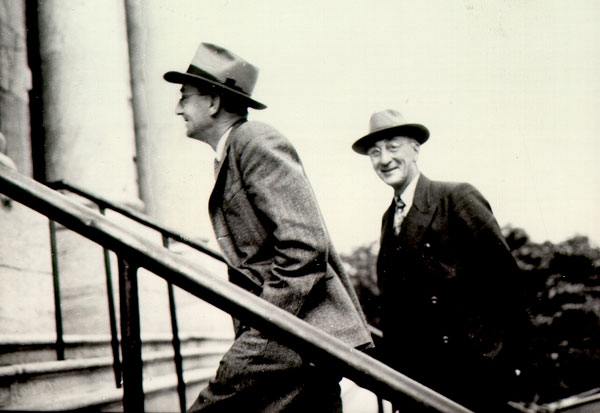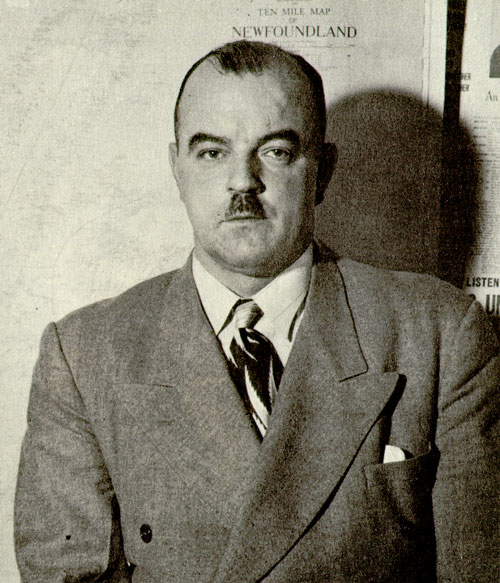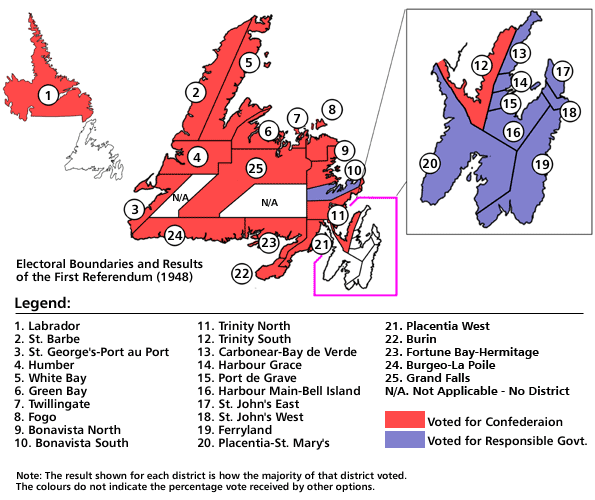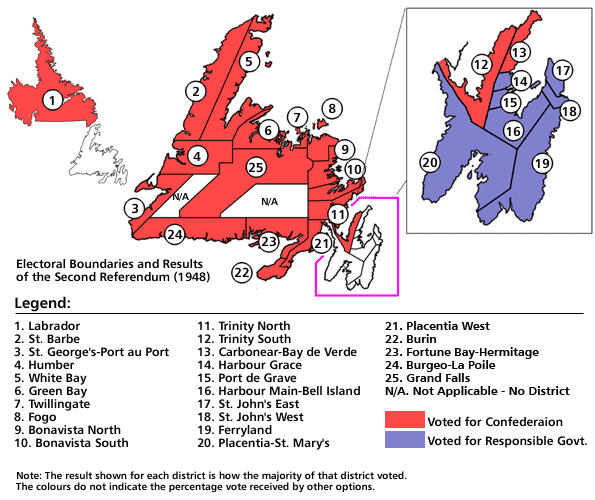The 1948 Referendums
The British government's decision to include confederation on the referendum ballot was probably expected by the confederates. The Confederate Association - with Bradley as President and Smallwood as Campaign Manager - was launched on 21 February 1948, well before the ballot announcement on 11 March.

Division Amongst Anti-Confederates
The anti-confederates, though, seem to have been taken by surprise. They had not anticipated that the recommendations of the National Convention might be disregarded. Where now was British fair play and justice?
The anti-confederate forces were divided between the Responsible Government League [RGL] and the Economic Union Party [EUP]. The RGL advocated a simple return to the status Newfoundland had held in 1933. Formed in February 1947 it had not proved very effective, with the result that a group of younger anti-confederates formed the EUP, led by Chesley Crosbie, which promoted the idea of a special economic relationship with the United States. Relations between the two parties were tense.

As a result, the anti-confederate campaign was disunited, lacked strong leadership, and was inadequately organized. It was inadequately funded, and failed to mount a really professional, island-wide campaign. All the same, there was a considerable amount of anti-confederate support from business people and Newfoundland patriots.

The stand taken by the Roman Catholic Archbishop, E.P. Roche, was very significant. The Monitor, the archdiocese's newspaper, took a strongly anti-confederate line.
The Confederate Association
In contrast, the Confederate Association was better funded, better organized, and had an effective island-wide network. Smallwood, Bradley and others campaigned hard and with considerable skill and confidence. Smallwood predicted that confederation would secure between 60,000 and 70,000 votes in the 3 June referendum.
He was right. Confederation received 64,066 votes, 41.1 percent of the total. But the winner was responsible government with 69,400 votes (44.6 percent). Commission government was last, with 22,311 votes (14.3 percent). A second referendum was set for 22 July, with Commission dropped from the ballot.

The confederates realized that victory was within reach. There had been more votes against than in favour of responsible government, a fact that was not lost on the anti-confederates either. For them, this was not the encouraging sign that it was for the confederates, who entered the second campaign with energy and enthusiasm. The RGL and the EUP joined forces, but morale had been shaken, former supporters were hedging their bets, and the anti-confederate cause remained comparatively disorganized.
In order to win additional votes, the confederates adopted two new tactics. First, they decided to emphasize the role played by the Roman Catholic Church in the first referendum, and so swing Protestant votes to confederation. In early July, as a result of confederate pressure, the Provincial Grand Lodge of the Loyal Orange Association issued a circular letter to all members. It cited the role played by the Roman Catholic Church, condemned "such efforts at sectional domination", and warned Orangemen of the dangers of such influence, which they should resist.
Second, the confederates attacked the members of the EUP for being disloyal, anti-British and pro-republican. Confederation was presented as pro-British, and "British Union" became a new slogan. An anti-confederate response was to plaster St. John's with posters reading "Confederation Means British Union With French Canada." The vote which followed this unpleasant campaign resulted in a victory for confederation, which gained 78,323 votes (52.3 percent). Responsible government received 71,334 votes (47.7 percent).

The Referendums
In both referendums, the Avalon Peninsula supported responsible government, and the rest of the country confederation. Also, a majority of the districts where most voters were Roman Catholics supported responsible government. There were confederate victories in the second referendum in Placentia West and St.George's-Port-au-Port, both predominantly Catholic areas.
| Responsible Government | Confederation | Commission | |
|---|---|---|---|
| Avalon | 67% | 25% | 8% |
| Other Districts | 26% | 54% | 20% |
| Responsible Government | Confederation | |
|---|---|---|
| Avalon | 66% | 34% |
| Other Districts | 30% | 70% |




